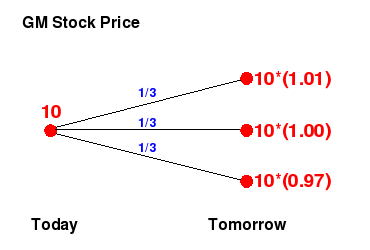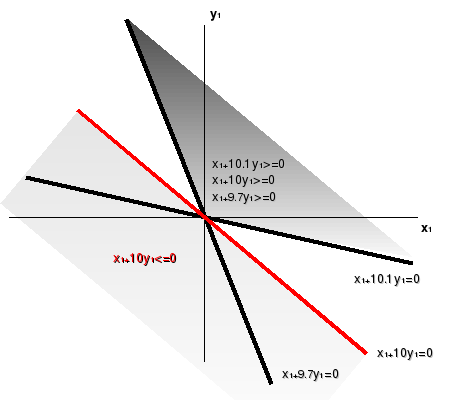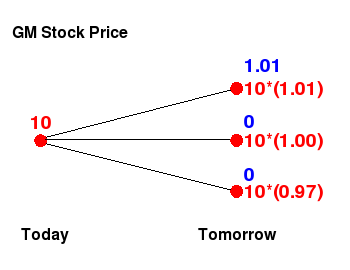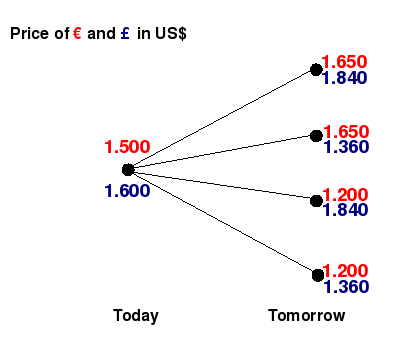In the previous lesson we observed that by
exogenously prohibiting
short-selling a complete
market may become incomplete. This model was the first
example of an incomplete market. In this lesson we will expose an
internal characteristic of the market that can make it incomplete which
does not involve any constraints on the set of trading strategies. As
we mentioned in lesson
8 the models considered so far are one-factor models in the
sense that at any time the price variance can be determined by flipping
one coin because there are only two possible rates of return. We will
see in this section that by allowing more than two rates of return at
anytime the market of module 1 might no longer be complete.
Example: General Motors' (GM) stock, multi-factor
case
Suppose that GM's stock price behaves as shown in the tree below. On
top of each edge in the tree we have placed the corresponding
probability. Observe that in this case there are three possible rates
of return, either the price goes up by 1%, remains unchanged or goes
down by 3%. Each event can occur with the same probability.

Intuitively, the arbitrage-free condition in this case should remain
invariant, i.e.
d< r< u where,
d,
r and
u are the lowest rate of return,
the interest on the dollar and the highest rate of return,
respectively. Because if this is not the case, there are arbitrage
opportunities like the one presented in example 3 of
lesson
2. Suppose for instance that
r=0. We
argue as we did in the previous lesson. As shown in the figure below,
the set of trading strategies with nonpositive initial value and the
set of strategies that are nonnegative in the three states of the world
can be represented by a semiplane and a cone, respectively.

The only strategy in the intersection of the semiplane with the cone is
x1=0=y1,
which is not an arbitrage opportunity.
We
leave as an exercise for the reader to check that the same holds when
assuming r to be any value strictly between d=-0.03
and u=0.01. We might ask then,
what is the difference between this
multi-factor model and the one factor model considered in the previous
lessons? The main difference is that under these
hypotheses on the price movement of GM's stock the model is no longer
complete.
To see this consider a call option with maturity of one day and strike
price equal to 10. The payoffs under the different states of the world
for this option are colored in blue in the tree below.

In order to hedge a position on the call option an investor would
like to find an strategy
(x1,y1)
on the money market account and GM stock, respectively. The strategy would solve the
following system of three linear equations in two unknowns (see
lesson
5).

This system has no solution and hence
the
model is not complete. We can also argue that the model is
not complete by using the
second
fundamental theorem of asset pricing. But before doing so we
have to identify what the
martingale
measures are in this model. A probability measure in this
case, can be identified with a triple
(p,q,r) that
specifies the probability of the price going up, staying constant and
going down respectively. Since in our example
r=0,
the martingale property reduces to having expectation equal to 10, i.e.

The other conditions on
p, q and
r
come from the restrictions that they have to be probabilities and hence
p+q+r=1 and since the original
probabilities are all equal to 1/3, in order to have an
equivalent
probability we must require
p,q,r to be
strictly positive. It is easy to see that there exist infinitely many
triples
(p,q,r) that satisfy the conditions above
(some examples are
p=3/5, q=r=1/5 and
p=1/2,
q=1/3, r=1/6) and by the second fundamental theorem of asset
pricing the model is incomplete. It is important to mention that the
fact that there exist at least one triple that satisfies all the
conditions guarantees that the model is arbitrage-free by the
first
fundamental theorem of asset pricing. The same argument can
be used to prove that the model is arbitrage-free if and only if
-0.03=d<
r< u=0.01.
Activity 1
Suppose that the exchange rate between the Euro and dollar today is
€1=$1.5. Tomorrow the price of the Euro either goes up by 10%, stays
constant or goes down by 20%. Each event has the same probability of
occurring. Assuming that the interest rates on the Euro and the dollar
are equal to 0, explain why this model is arbitrage free. Find all the
possible martingale measures for this model and deduce that the model
is incomplete. Give an example of a financial derivative that cannot be
perfectly
hedged in the model.
Example: Dollar Vs Euro, Dollar Vs British Pound,
non-correlated case
Recall the example presented at the beginning of
lesson
8. In that model there were only two possible states of the
world either the price of the Euro and pound go up or they go down.
This implies that in our model we are assuming that the dollar price of
the Euro and the British pound are perfectly correlated. By considering
a more general scenario
where the
interest rates on the Euro, dollar and British pound are all equal to 0,
and the correlation hypothesis is dropped we obtain a multi-factor
model. In this model we have four states of the world, which we present
in the tree below. We have added two branches corresponding to the
states of the world in which one price goes up but the other goes down.

In order to find the risk-neutral measures in this model (see
lesson
8), we have to find
(p,q,r,s), strictly
positive numbers such that

It can be shown that there are infinitely many of such quadruples and
hence the market is arbitrage-free but incomplete.
Activity 2
Conduct the same analysis as the one exposed above for the model of
activity 2b) in
lesson
8. In other words study the case when stock's price of
General Motors and Ford are not correlated.
There is a natural extension of the results presented in lessons 7
through 9 to the multi-factor case. We leave this extension as an
exercise for the interested reader.